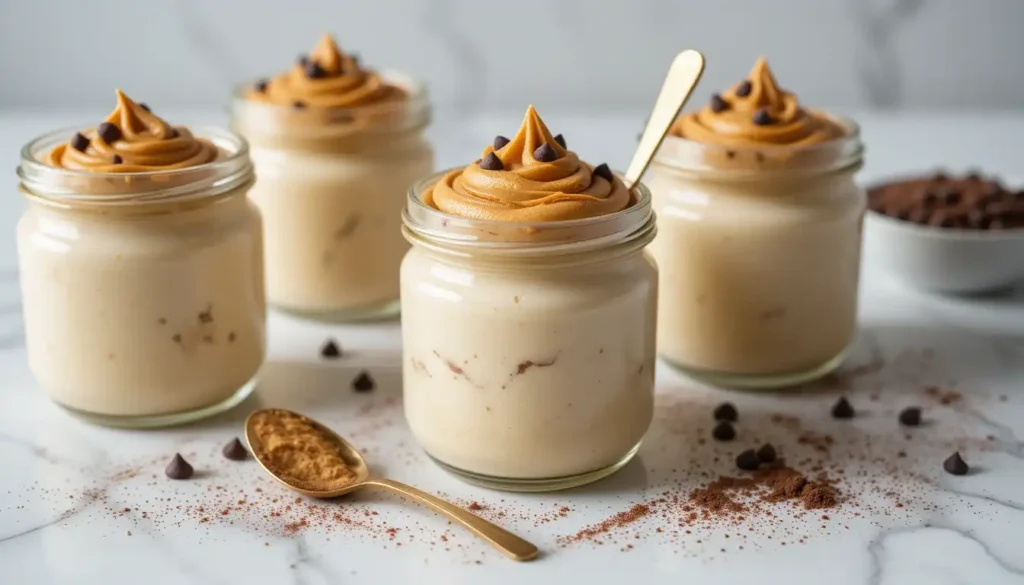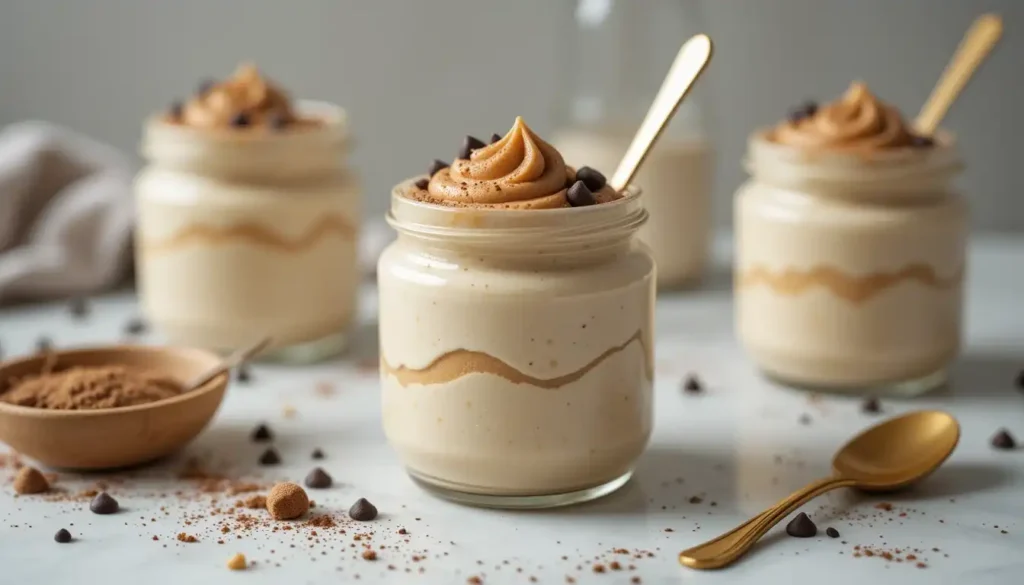Table of Contents
Looking for a dessert that satisfies your sweet cravings without derailing your health goals? Cottage Cheese Peanut Butter Mousse is the perfect fusion of creamy, nutty, and slightly sweet flavors—packed with protein, healthy fats, and minimal sugar. This recipe has recently gained traction among fitness enthusiasts, low-carb dieters, and busy families looking for quick, nutritious treats.
Whether you’re meal prepping for the week or seeking a post-workout snack, this mousse is a wholesome, indulgent solution that’s as easy to make as it is delicious.
What Is Cottage Cheese Peanut Butter Mousse?
Cottage Cheese Peanut Butter Mousse is a light, fluffy dessert made by blending cottage cheese with natural peanut butter, sweeteners, and flavorings like vanilla extract or cocoa powder. It delivers the richness of traditional mousse without the added sugar, cream, or eggs.
This dessert fits easily into:
- High-protein diets
- Low-carb/keto lifestyles
- Gluten-free plans
For anyone exploring alternatives to sugar-loaded desserts, this mousse offers a clean, nutrient-dense profile. And the best part? It’s incredibly versatile you can customize flavors and textures with ease.
According to Harvard School of Public Health, incorporating high-protein dairy and nut products into your diet can help with muscle repair and appetite regulation.
Additionally, Cleveland Clinic’s guide to peanut butter nutrition highlights that peanut butter is a source of monounsaturated fats and essential vitamins, making it a smart choice when used moderately.

Health Benefits of Cottage Cheese Peanut Butter Mousse
Here’s why this mousse stands out among health-conscious eaters:
- High Protein: Both cottage cheese and peanut butter are rich in protein, aiding in muscle maintenance and post-workout recovery.
- Low Sugar: You can control the sweetness by using natural or sugar-free alternatives like monk fruit, stevia, or erythritol.
- Healthy Fats: Peanut butter provides heart-friendly monounsaturated fats.
- Rich in Calcium and Probiotics: Cottage cheese contains calcium for bone health and probiotics to support digestive wellness.
- Satiety Factor: The protein and fat combination helps you feel full longer, curbing the urge to snack on less nutritious options.
Ingredients and Substitutions
Core Ingredients:
- 1 cup cottage cheese (full-fat for creaminess)
- 2 tablespoons natural peanut butter
- 1–2 tablespoons honey, maple syrup, or sugar-free sweetener
- ½ teaspoon vanilla extract
Optional Add-ins:
- 1 tablespoon cocoa powder (for a chocolate mousse)
- 1 tablespoon chia seeds (adds fiber and thickness)
- Chopped nuts, fresh berries, or granola for texture
Substitutions:
- Swap almond butter or cashew butter for peanut butter
- Replace cottage cheese with Greek yogurt if desired
- For vegan versions, use plant-based cottage cheese alternatives
Step-by-Step Recipe Guide
1. Prepare the Ingredients
- Use fresh, high-quality cottage cheese and unsweetened peanut butter.
- Choose your sweetener based on dietary needs.

2. Blend the Base
- In a blender or food processor, combine:
- 1 cup cottage cheese
- 2 tablespoons peanut butter
- 1–2 tablespoons sweetener
- ½ teaspoon vanilla extract
- Blend until the mixture is completely smooth and mousse-like. This usually takes 1–2 minutes.
3. Adjust Consistency
- If the mousse is too thick, add a splash of unsweetened almond milk or water.
- If too runny, stir in a small spoonful of chia seeds and let it sit for 10–15 minutes.
4. Serve and Store
- Chill for 30 minutes before serving for best texture.
- Store leftovers in an airtight container in the fridge for up to 3 days.
- Not recommended for freezing as it alters the texture.
Variations to Try
Switch up your mousse routine with these delicious spins:
- Chocolate Peanut Butter Mousse: Add cocoa powder or melted dark chocolate for a dessert-like version.
- Berry Swirl Mousse: Blend or swirl in fresh strawberries, raspberries, or blueberries.
- Crunchy Delight: Fold in chopped peanuts, almonds, or granola.
- Vegan Friendly: Use plant-based cottage cheese and almond butter.
- Keto Variation: Stick to full-fat dairy and sugar-free sweeteners for a low-carb treat.
Nutritional Information (Per Serving)
Here’s a rough breakdown based on standard ingredients (serving size: ~½ cup):
- Calories: 200–250
- Protein: 15–20g
- Fat: 10–15g
- Carbohydrates: 5–10g
- Sugar: 2–5g (depending on sweetener)
Compared to traditional mousse recipes that use cream, sugar, and eggs, this version is significantly lighter, cleaner, and more nutrient-dense.
Common Mistakes and How to Avoid Them
Avoid these missteps for a perfect mousse every time:
- Grainy Texture: Always blend until completely smooth. Cottage cheese can be lumpy if not fully processed.
- Overpowering Peanut Flavor: Balance is key—use vanilla and sweetener to complement, not mask.
- Too Thick or Runny: Adjust with liquid or chia seeds as needed.
- Poor Storage: Keep mousse chilled and consume within 3 days for best quality.

Serving Suggestions and Pairings
Whether you’re hosting or prepping, here’s how to enjoy it:
- As a Dessert: Serve in a glass or ramekin with a dusting of cocoa or cinnamon.
- With Fruit: Pair with apple slices, banana rounds, or fresh berries.
- As a Snack: Great with whole grain crackers or on a slice of toast.
- Beverage Pairings: Complement with black coffee, herbal tea, or a protein smoothie.
Frequently Asked Questions
Can I mix peanut butter and cottage cheese together?
Yes, mixing peanut butter and cottage cheese is not only safe but also delicious and nutritious. The combination creates a creamy, protein-rich snack or dessert that balances healthy fats, protein, and flavor. Blending the two makes the texture smoother and more mousse-like.
What are common mistakes when making mousse?
- Not blending cottage cheese enough, which can leave a grainy texture.
- Using too much sweetener or peanut butter, which overpowers the flavor.
- Not chilling the mousse, resulting in a runny or less firm consistency.
- Freezing the mousse, which can cause separation and texture changes.
What’s the difference between whipped cottage cheese and regular cottage cheese?
Whipped cottage cheese is blended until smooth, resulting in a creamy, spreadable texture—ideal for mousses and dips. Regular cottage cheese has visible curds and a chunkier texture. Whipping it improves palatability and versatility in recipes.
How do you jazz up cottage cheese?
- Add fruit, honey, or cinnamon for sweetness.
- Mix in herbs, tomatoes, or cucumbers for a savory option.
- Use it as a dip base, topping, or mousse ingredient.
- Blend with nut butters or protein powder for a snack upgrade.
What to avoid in cottage cheese?
- Added sugars and artificial flavors in flavored varieties.
- Low-quality thickeners or gums that affect texture and digestion.
- Overly salty brands, which can be high in sodium.
Always check the label for clean ingredients.
What’s better, Greek yogurt or cottage cheese?
Both are excellent protein sources. Greek yogurt is typically creamier with more probiotics, while cottage cheese is higher in protein and lower in sugar. The better option depends on your taste preference and dietary goals.
Is cottage cheese OK to eat every day?
Yes, it’s generally safe to eat daily, especially if you choose a low-sodium, high-quality brand. It supports muscle repair, bone health, and can fit into most balanced diets. Moderation is key to avoid excess sodium or saturated fats.
Is cottage cheese anti-inflammatory?
Full-fat dairy, including cottage cheese, can have mild inflammatory effects in some people, especially if lactose intolerant. However, many studies suggest that dairy in moderation does not contribute to systemic inflammation for most individuals.
Which is healthier: sour cream or cottage cheese?
Cottage cheese is healthier overall—it’s lower in fat and calories and significantly higher in protein. Sour cream is richer but offers fewer nutritional benefits. For health-focused recipes, cottage cheese is the better substitute.
What brand is the healthiest cottage cheese?
Look for brands that are:
- Low in sodium
- Free from added sugar and preservatives
- Made with simple ingredients
Some of the best-rated brands include Good Culture, Nancy’s, and Organic Valley for their clean labels and probiotic content.
What is the 3-day cottage cheese diet?
It’s a short-term, low-calorie diet where cottage cheese is the main protein source, combined with fruits, vegetables, and lean meats. While it may lead to quick weight loss, it’s not recommended long-term due to nutritional imbalances and calorie restrictions.
Is cottage cheese hard on your gut?
For most people, cottage cheese is gut-friendly, especially when it contains live cultures. However, individuals with lactose intolerance or dairy sensitivity may experience bloating or discomfort. Choosing lactose-free options can help alleviate this.
Conclusion
In today’s fast-paced world, finding recipes that strike the perfect balance between nutrition, convenience, and flavor can be challenging. Cottage Cheese Peanut Butter Mousse offers a delicious solution for anyone looking to eat cleaner without giving up the joy of indulgence. With just a few simple ingredients and a blender, you can whip up a dessert or snack that’s packed with high-quality protein, healthy fats, and minimal sugar—ideal for a wide range of dietary lifestyles.
Whether you’re focused on building muscle, following a low-carb or keto diet, or simply aiming to reduce your intake of processed sweets, this mousse checks all the boxes. Its creamy texture and nutty-sweet flavor make it incredibly satisfying, while its nutrient profile supports long-term health and satiety. Plus, the flexibility in ingredients allows for endless customization, so you can make it your own with add-ins like cocoa, berries, or granola.
Beyond its nutritional value, this mousse is also kid-friendly, budget-conscious, and easy to prepare in advance. It’s a standout example of how wholesome ingredients can be transformed into something that feels indulgent without being unhealthy.
So, the next time you’re craving something sweet, skip the processed snacks and blend up a batch of Cottage Cheese Peanut Butter Mousse. You’ll get all the satisfaction of dessert, minus the guilt—and your body will thank you for it.
Now that you know how easy and beneficial it is, why not make it part of your regular routine? Healthy eating never tasted so good.
Easy Allrecipes
1-Italian Sausage Parmesan Pasta – Easy, Creamy, and Flavor-Packed
2-Tender Slow-Cooked Beer Braised Beef Tacos Recipe (Easy & Flavorful)
3-10 Secrets to Making the Best Fresh and Tasty Potato Salad
4-Creamy Crab and Shrimp Seafood Bisque – The Ultimate Homemade Recipe
5-Dino Beef Ribs: The Ultimate Guide to Smoking, Seasoning & Serving
6-Street Corn Chicken Rice Bowl – A Smoky, Creamy & Delicious Meal
7-Honeynut Squash Ragu – A Rich & Flavorful Fall Pasta Sauce
8-Garlic Steak Bites and Potatoes | Quick & Easy One-Pan Recipe
9-Sheet Pan Salmon with Asparagus – Easy, Healthy & Delicious Recipe
10-How to Make the Best Salisbury Steak with Mushrooms – Easy & Flavorful Recipe

